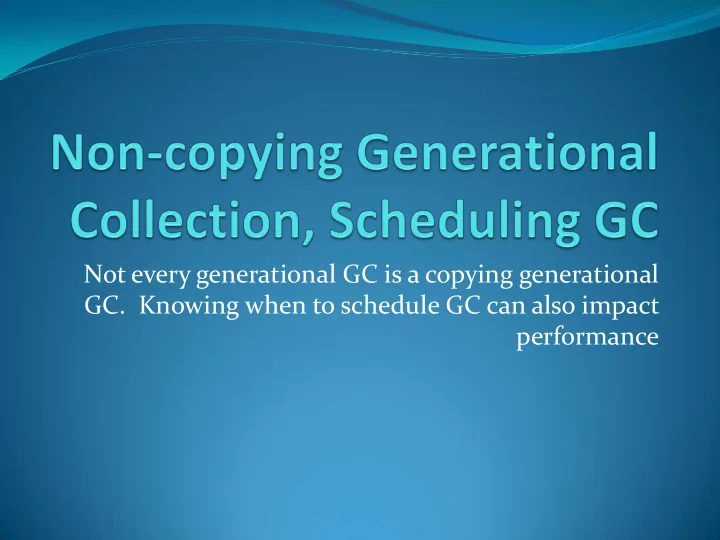

Not every generational GC is a copying generational GC. Knowing when to schedule GC can also impact performance
Which pointer writes to trap Writes that may not need to be trapped Stores to registers Stores to stack Initializing stores Not easy to detect in many languages These stores form the majority of pointer stores Stores that should be trapped Non-initializing stores ~ 1 % of instructions generated by Lisp or ML compilers 2
Trapping & recording inter-gen ptrs Entry tables Remembered sets Sequential store buffer Page marking with hardware support Page marking with virtual memory support Card marking 3
Card marking Divide heap into # regions called cards Smaller than pages (~ 128 Bytes) Requires card table Bit is set in card table for a card whenever a word in the card modified Scans dirty cards for inter-generational ptrs at collection time Advantages Portable Independent of virtual memory system Flexible card size can be picked to optimize locality 4
Card marking Cost of scanning Proportional to number of cards marked Proportional to size of card GC can use dirtiness info to Segregate objects on written-to-cards from clean cards Gather dirty cards on same virtual memory page # pages holding cards to be scanned is reduced 5
Non-copying generational GC Mark-sweep based generational GC Yields no worse performance than copying base collectors Zorn’s system Four generations, each containing a mark bitmap fixed-sized-object region variable-sized-object region 6
Zorn’s fixed -sized-object region Divided into # areas Each area stores objects of a fixed size Uses mark-and-deferred-sweep GC Promotes objects en masse by copying, after 3 collections 7
Zorn’s variable -sized object region Holds object that cannot fit in any of the fixed-sized object areas Collects with two semi-space copying collector Zorn’s finding Mark-sweep collector suffered from greater CPU overhead Mark-sweep collector required 30% to 40% less real memory than the copying collector Promotion thresholds, pause times, cache miss ratio were important 8
When do we schedule GC Two options: Hide collections at times when user least likely to notice pauses Trigger efficient collections when there is likely to be most garbage collected 9
Hiding garbage collection In long lived systems Perform GC overnight Perform GC when machine is idle Perform GC at points in program when pause is less likely to be disruptive End of compute-bound periods Volume of live data is low User given opportunity to interact with program and does not do so Can attach code to monitor user interaction (good heuristic) Emacs uses this strategy 10
Key objects as indicators Hayes observed that death of objects allocated at roughly the same time closely correlate Object demographics arise from typical programming style Few static pointers to large data structures e.g., root of a tree data structure When program finish with tree it is only accessible from root When ptr to root is deleted, entire tree is garbage Use these key objects as indicators for GC When death of a cluster no longer predictable by their age, should be promoted out of time-based generation One key object (root of tree) retained in generational scheme 11
Key objects before promotion Root set Keyed Area Young Objects 12
Key objects after promotion Root set Keyed objects Keyed Area Young Objects 13
Using a mature object space Promote very old objects out of time-based generation scheme into mature object space, all at once Avoid disruptive collections Mature object space divided into areas, each with remembered set Each collected one at a time in round-robin fashion Area is collected when its remembered set is empty What if objects too big to fit in one area? Use carriages and train analogy 14
Recommend
More recommend